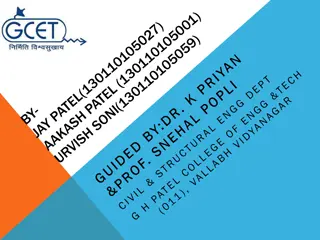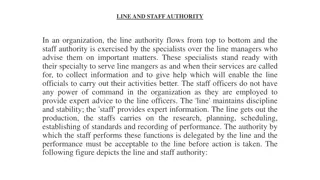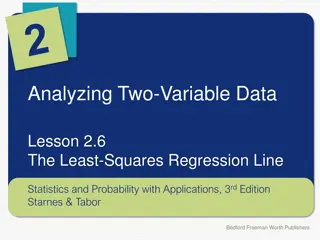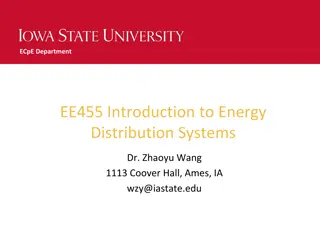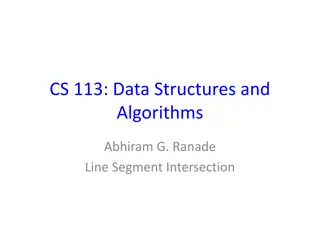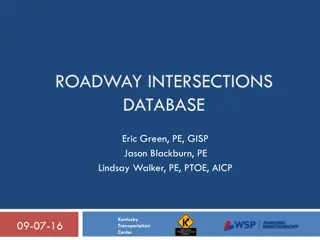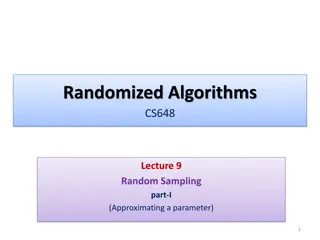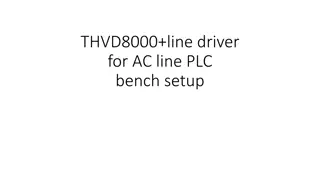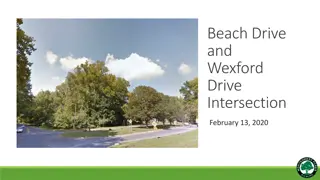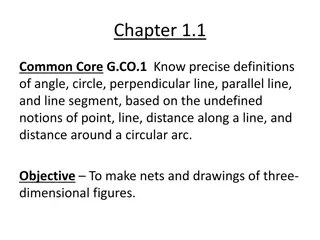Line Segment Intersection
Geometric intersections play a crucial role in computational geometry for tasks such as solid modeling, collision detection in robotics, and overlaying subdivisions in geographic information systems. The problem of line segment intersection involves finding all intersection points between a set of closed line segments in the plane. Algorithms like the Bentley-Ottmann algorithm provide efficient solutions, with a runtime of O((n+k)logn), where n is the number of line segments and k is the size of the output. The complexity theory shows the optimality of O(nlogn + k) runtime for certain decision problems.
Download Presentation

Please find below an Image/Link to download the presentation.
The content on the website is provided AS IS for your information and personal use only. It may not be sold, licensed, or shared on other websites without obtaining consent from the author.If you encounter any issues during the download, it is possible that the publisher has removed the file from their server.
You are allowed to download the files provided on this website for personal or commercial use, subject to the condition that they are used lawfully. All files are the property of their respective owners.
The content on the website is provided AS IS for your information and personal use only. It may not be sold, licensed, or shared on other websites without obtaining consent from the author.
E N D
Presentation Transcript
Line Segment Intersection Michael Goodrich Univ. of California, Irvine Some slides from CMPS 3130/6130 Computational Geometry, Spring 2015, by Carola Wenk 1
Geometric Intersections Important problem in Computational Geometry Solid modeling: Build shapes by applying set operations (intersection, union). Robotics: Collision detection and avoidance Geographic information systems: Overlay two subdivisions (e.g., road network and river network) 2
Line Segment Intersection Input: A set S={s1, , sn} of (closed) line segments in R2 Output: All intersection points between segments in S 3
Line Segment Intersection n line segments can intersect as few as 0 and as many as =O(n2) times Simple algorithm: Try out all pairs of line segments Takes O(n2) time Is optimal in worst case Challenge: Develop an output-sensitive algorithm Runtime depends on size k of the output Here: 0 k n2 Our algorithm will have runtime: O( (n+k)log n) This algorithm is due to Bentley and Ottmann Best possible runtime: O(n log n + k) O(n2) in worst case, but better in general n 2 4
Output size for intersections k = # of intersections k = 2 k = 18 5
Output size for intersections Range of k can go from 0 to n choose 2, i.e., n(n-1)/2, which is O(n2). k = 0 k = 6(5)/2 = 15 6
Complexity Why is runtime O(n log n + k) optimal? The element uniqueness problem requires W(n log n) time in algebraic decision tree model of computation (Ben-Or 83) Element uniqueness: Given n real numbers, are all of them distinct? Solve element uniqueness using line segment intersection: Take n numbers, convert into vertical line segments. There is an intersection iff there are duplicate numbers. If we could solve line segment intersection in o(n log n) time, i.e., strictly faster than (n log n), then element uniqueness could be solved faster. Contradiction. 7
Plane sweep algorithm Cleanliness property: All intersections to the left of sweep line l have been reported Sweep line status: Store segments that intersect the sweep line l, ordered along the intersection with l . Events: Points in time when sweep line status changes combinatorially (i.e., the order of segments intersecting l changes) Endpoints of segments (insert in beginning) Intersection points (compute on the fly during plane sweep) 8
General position Assume that nasty special cases don t happen: No line segment is vertical Two segments intersect in at most one point No three segments intersect in a common point 9
Event Queue Need to keep events sorted: Lexicographic order (first by x- coordinate, and if two events have same x-coordinate then by y-coordinate) Need to be able to remove next point, and insert new points in O(log n) time Use a balanced binary search tree (e.g., a WAVL tree) The de Berg book sweeps top to bottom, but I like to sweep left-to- right. So pictures from the book are sideways 10
Sweep Line Status Store segments that intersect the sweep line l, ordered along the intersection with l . Need to insert, delete, and find adjacent neighbor in O(log n) time Use balanced binary search tree, storing the order in which segments intersect l in leaves b c e d c b e d 11
Event Queue The events in the event queue (sorted by x- coordinates): Every line-segment endpoint (left and right) The intersection point of every pair of line segments that are consecutive in the ordering along the sweep line. 12
Event Handling 1. Left segment endpoint Add new segment to sweep line status Test adjacent segments on sweep line l for intersection with new segment Add new intersection points to event queue b c a e d c b d c b e d 13
Event Handling 2. Intersection point Report new intersection point Two segments change order along l Test new adjacent segments for new intersection points (to insert into event queue) b c a e d Note: new intersection might have been already detected earlier. c b e d c e b d 14
Event Handling 3. Right segment endpoint Delete segment from sweep line status Two segments become adjacent. Check for intersection points (to insert in event queue) b c a e d e c b d e c d 15
Intersection Lemma Lemma: Let s, s be two non-vertical segments whose interiors intersect in a single point p. Assume there is no third segment passing through p. Then there is an event point to the left of p where s and s become adjacent (and hence are tested for intersection). Proof: Consider placement of sweep line infinitesimally left of p. s and s are adjacent along sweep line. Hence there must have been a previous event point where s and s become adjacent. s p s 16
Runtime Sweep line status updates: O(log n) Event queue operations: O(log n), as the total number of stored events is 2n + k, and each operation takes time O(log(2n+k)) = O(log n2) = O(log n) k = O(n2) There are O(n+k) events. Hence the total runtime is O((n+k) log n) 17




